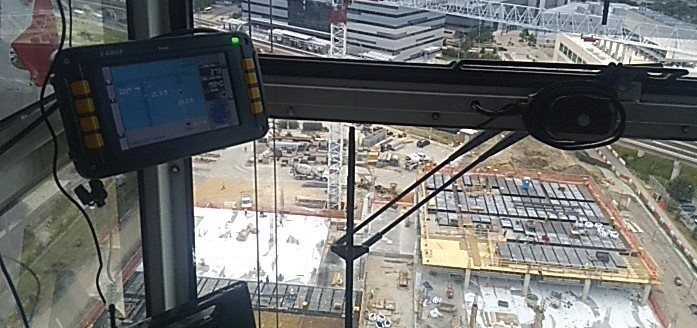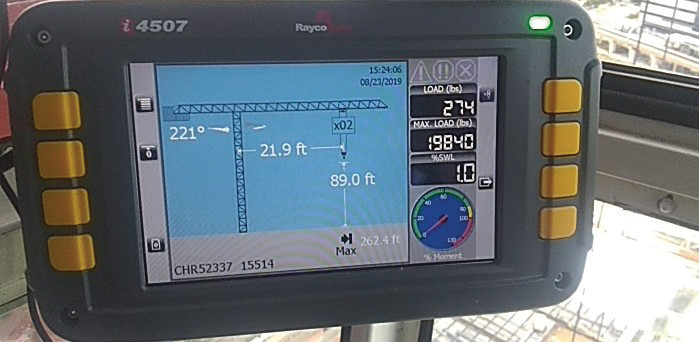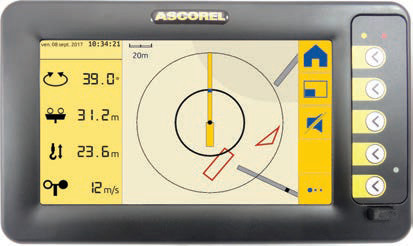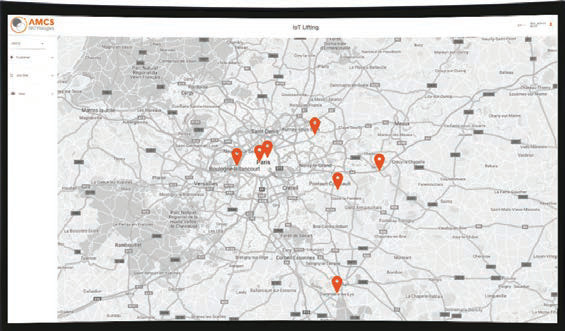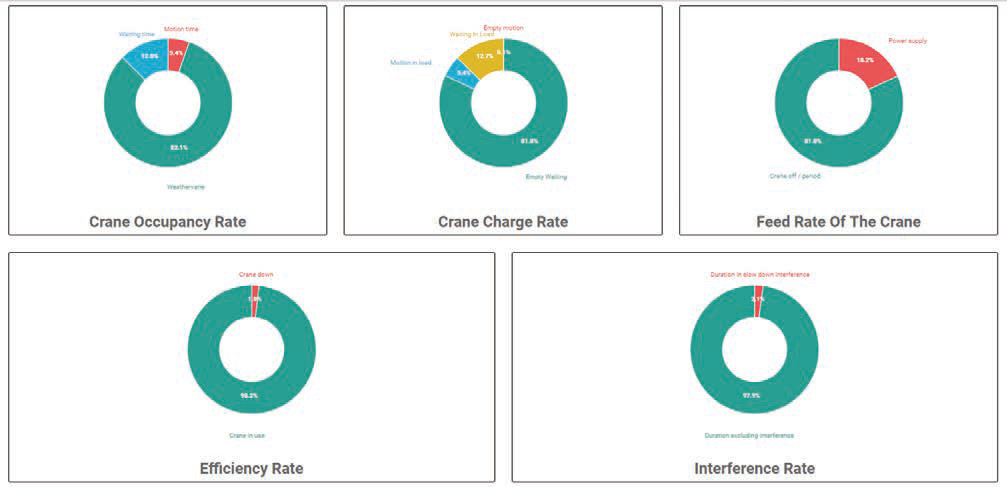A wider, safer working zone
17 September 2019In recent years, anti-collision systems have developed into new areas, offering improved integration with crane controls, cameras, and BIM systems. John Bensalhia reports.
Today's anti-collision systems offer a greater degree of transparency for the crane user. Jean-Charles Delplace, general manager, SMIE and CEO & founder, Smart Jobsite, says: “Today's technology is similar to driving a modern car, which, these days, has a radar and camera to give you vision for when you reverse. Our system is like that, as the crane driver can see the job site activity all around.”
The camera and display system is now such an integral part of the crane that it feels like it has always been there. “You feel like it's a natural part of the crane,” says Delplace. “When you don't use it, it's like you feel that something's missing.”
Delplace adds that Building Information Modelling (BIM) is very much the “subject of the day”, optimising and improving crane performance.
BIM provides a digital representation of a facility or job site's physical and functional characteristics. The appropriate information collated through digital captures is then processed, shared and networked—ensuring a detailed, transparent and rocksolid source of data. Because it provides fast, up-to-date information about the facility, BIM provides a concrete foundation for making important decisions when embarking on new projects.
“There is a huge amount of new technology that we can bring,” says Delplace. “The main goal is to monitor and improve the layout of the job site, boosting workplace efficiency in the process. We can potentially see a system that merges crane with BIM and anticollision.”
Anti-collision and BIM are closely intertwined. An example of this is the recent news of two important respective businesses coming together. Earlier this year, anti-collision specialist company SMIE announced its merger with job site BIM supplier, Smart Jobsite. The two French-based companies will merge at corporate level, while continuing to run independently.
“It's the perfect integration of the crane and BIM,” says Delplace. “On the one side, you have a company which is a young start-up. On the other, you have a 45-year-old company that is well established in its market. By merging two innovative companies, it extends the footprint.”
The SMIE/Smart Jobsite system is based on two levels of communication. “The first is through radio, with the network allowing for position transference of the crane. The second is through a Wi-Fi network that transfers all the data from the worksite, which can then be downloaded and used,” explains Delplace. A major benefit of this facet is that data can be used remotely through PC and Internet connection.
“What Smart Jobsite is working on right now is to link this with BIM, as well as working on the right software for the market. Many customers dream of having a central offering of self-driving cranes with BIM in an integration solution that works. The dream of having BIM crane tool habitation is coming true—we are seeing very positive developments.”
Emmeline Grosjean, sales and communication department at AMCS technologies, says that a notable modern trend is the move towards the digital transition, and consequently, to the expansion of skills in order to offer comfort options to the customers. “The market tends to offer digital tools grouping several functions in a single product.
“Today, the reliability and safety research for the products in order to guarantee the productivity of construction sites is a major focus for companies. Our research and development department is working on the development of new products incorporating new technologies.”
Having already developed a job site supervisor—the SUP 60—and a second, more advanced version—the SUP 61—the R&D department of AMCS technologies has worked on a new model that integrates the BIM. Grosjean says this has been in development since the beginning of 2019. The supervisor SUP BIM will be marketed from beginning of 2020 in France and abroad.
“This site supervisor tool makes it possible to follow in real time the evolution and production of the job site,” says Grosjean. “It recreates the construction site in a virtual way by integrating the real types, brands and models of cranes on the site plan and in their environment (buildings, road, location…) and the digital models of buildings under construction in BIM format.”
Businesses using the supervisor SUP BIM will get benefits both in terms of safety and work efficiency. This site supervision tool allows to follow in real time the evolution and production of the job site. “As a construction site is, by definition, a constantly evolving environment, the SUP BIM promotes a global and continuous vision of safety on the construction site at all stages of construction,” explains Grosjean. “For a better understanding of the project throughout its life cycle, it allows to view the evolution of the site and its facilities as it progresses.”
Grosjean adds that it is a crucial aid to decision making. “It allows to see in real time the evolution of the buildings under construction, crane movements and the data collected by the anti-collision system installed on the crane (wind speed, position of the truck, height of the load, slewing of the crane and others).”
AMCS has also developed a new IOT (Internet-of-Things) Lifting System, which connects and presents data from the company’s other products. Grosjean explains that thanks to the data logger function of the anti-collision systems DCS 60 and/or DCS 61-S installed on cranes, it gets a database gathering all the information of the activity and the events of the cranes and the construction site. “This information can be used in raw form but also in the form of statistics. In order to improve the productivity of the cranes, the user can thus know the utilisation rate of the crane under load/empty, and the rate of interference.”
Camera Mapping
Beck Group faced a number of challenges when taking on the job of building a new, 22-storey high Hilton Hotel in the American city of Denver. The central location was one such issue, with the potential fallout of congested traffic in such a busy area (which, in turn, would have presented difficulties when unloading incoming deliveries for building materials). With the added challenges of limited working space and the need for accurate concrete slab verification, a solution had to be found in order to prevent any errors, disruption and delays.
While drones can record aerial data, in some cases, it's not a practical solution. For the Beck Group, this option was out of the equation, given the busy environment. Safety issues, as well as the hassle of obtaining prior permission to fly the drones, and also the unpredictable nature of the weather were further considerations to take on board.
Instead, the Beck Group opted to use the Pix4D crane camera: a device that automatically captures and processes images from the work site. As the Beck Group found, by mounting the camera on a single tower crane, this meant that images could be captured autonomously. No need for extra personnel to do the job, and no unwanted hold-ups with jobs on the site.
The camera's capabilities include the daily monitoring of site progress via a cloud-based platform, which can be accessed via any device from a computer through to a mobile phone. In the case of the Beck Group, the team could regularly keep the shareholders updated without having to leave the office.
The system can quickly spot any possible errors in the construction process, relaying these to the team, who can take the necessary action to remedy mistakes and deviations from the schedule. With the meticulous precision needed for tasks such as the concrete slab verification, each stage was monitored daily by the camera. It's also a vital tool in detecting possible on-site crane collisions, pre-empting and preventing any harm being done both to the equipment and the personnel.
Grant Hagen, VDC manager at the Beck Group commented: “We used the data to check the site progress and to show it during our meetings with different subcontractors. Being able to present the slab installations and the daily progress of the site without physically being out on site was very helpful for us. The Crane Camera gave us full site awareness.
“I believe the biggest benefit of the Crane Camera is that it is a fully autonomous solution. It doesn’t require any human interaction, other than to consume the information. It’s really helpful, especially for people like us that traditionally have a lot of things on our plates.”
Modern anti-collision systems are designed to be as user-friendly as possible, bearing simplicity and convenience in mind. A case in point is RaycoWylie's i4508 tower crane anti-collision system, which efficiently eliminates the risk of onsite collisions. It's an ideal choice for businesses wanting assistance with lift planning and ensuring that any high-risk factors on-site are swiftly alerted to the crew.
As the newest model of its kind, nevertheless, the i4508 is still compatible with the previous i4507 load indicator system. The new system can be used in conjunction with the i4507, the display of which provides the user with the required information. As a result, there's no need to replace the older version, and a further bonus is that the crane cabin won't be filled with extra hardware.
The range of the RaycoWylie i4508 is impressive, encompassing a simultaneous monitoring capability of up to 21 cranes in a jobsite location, as well as detecting any potential site obstructions. Available as a 10in colour touchscreen display (with sensors), the i4508 can also be used with a tablet or a PC. A big benefit of the system is that users can share and exchange information wirelessly. On the subject of remote operations, the i4508 can remotely override the crane's AC system.
Ascorel's new product is dedicated to anti-collision and zoning management on construction sites, and is currently in the commercial launch phase.
“The MC 603 is equipped with modular technology and has been tested by major players in the sector for several months, which allowed us to better analyse the performances of the material,” says Franck Marchais, sales and marketing manager.
“It includes an electronic system covering all current and future standards, and a new software combining the best of our anticollision expertise, with the power of new predictive computing algorithms.”
Marchais says that the new MC 603 anti-collision system will meet all the requirements of BIM: “Today and even more tomorrow, anti-collision systems will be there to optimise the management of the whole construction site.” Additional features are already being developed on the MC 603 system, with the goal to bring more connectivity and support solutions to optimise crane and yard productivity.
Ascorel's crane anti-collision systems can be managed and monitored by the Supervisor 3. A connection is made between the Ascorel device and a local computer via the anti-collision radio network. With the internet server giving access to the information relayed by the anticollision systems, this means that it can be picked up anytime and anywhere in real time.
Another new innovation from Ascorel has been the introduction of ASCOLAB. “Ascorel does get out that the construction sector is changing,” says Marchais. “Connectivity and fleet management are increasingly required to allow managers to better track their fleet and their sites.”
“That's why, in collaboration with a long-time partner, a major player in the profession, we finalised this summer the creation of ASCOLAB, a laboratory of ideas whose mission is to imagine innovations based on control and monitoring integration, human and technology interfaces, and also data and systems.
“The group is therefore actively working on tomorrow's solutions such as BIM and connected solutions.”
The constant inroads into anticollision technology make for an eagerly anticipated future, with various projects and innovations lined up on the horizon. “AMCS has several projects in terms of development of features, products and site around the world, and should arrive very soon,” says Grosjean.
Delplace also says that there are many exciting plans in the pipeline at SMIE / Smart Jobsite. “There are many innovations that we are putting together. There is a lot in the bag that we will be releasing.”
Developing technology means that crane drivers can have access to real-time positioning, with a greater emphasis on the job site. “With respect to the environment, today's technology is all about the bigger picture,” concludes Delplace. “We've moved from just being crane-centric to both crane-centric and job site-centric. We can monitor both activity of the crane and the job site.” SMIE’s ProSite WiFi was used at the Davoies dam project in Portugal. The site was made more complex than usual by the presence of two Blondin devices being used alongside the cranes. Jean Charles Delplace said: “We were able to use a standard ProSITE system which kept the costs within normal parameters. We had ProSite running on a tablet, which could be used by the Blondin operator to create an immediate zone between the two tower cranes, that already had their own zones and anti-collision. If a crane was operating within the zone, the driver would receive a message asking them to move immediately”.
SMIE’s ProSite WiFi was used at the Davoies dam project in Portugal. The site was made more complex than usual by the presence of two Blondin devices being used alongside the cranes. Jean Charles Delplace said: “We were able to use a standard ProSITE system which kept the costs within normal parameters. We had ProSite running on a tablet, which could be used by the Blondin operator to create an immediate zone between the two tower cranes, that already had their own zones and anti-collision. If a crane was operating within the zone, the driver would receive a message asking them to move immediately”.
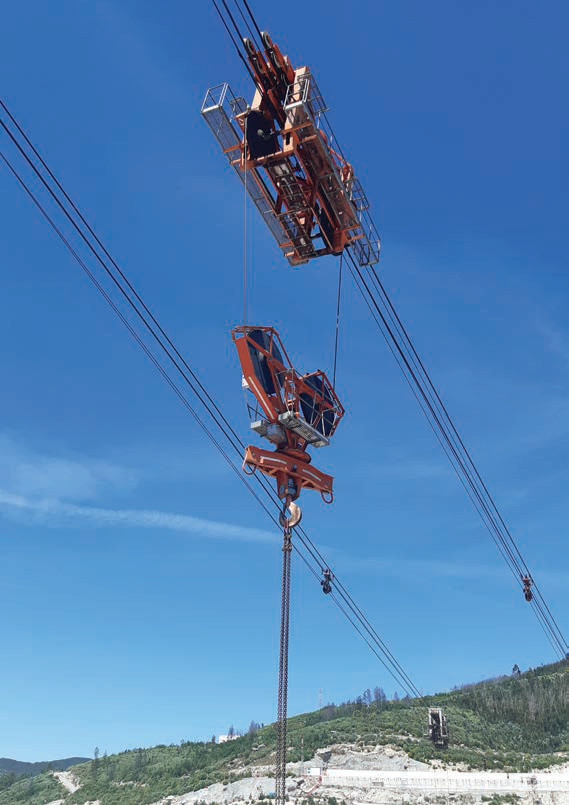 SMIE’s ProSite WiFi was used at the Davoies dam project in Portugal. The site was made more complex than usual by the presence of two Blondin devices being used alongside the cranes. Jean Charles Delplace said: “We were able to use a standard ProSITE system which kept the costs within normal parameters. We had ProSite running on a tablet, which could be used by the Blondin operator to create an immediate zone between the two tower cranes, that already had their own zones and anti-collision. If a crane was operating within the zone, the driver would receive a message asking them to move immediately”.
SMIE’s ProSite WiFi was used at the Davoies dam project in Portugal. The site was made more complex than usual by the presence of two Blondin devices being used alongside the cranes. Jean Charles Delplace said: “We were able to use a standard ProSITE system which kept the costs within normal parameters. We had ProSite running on a tablet, which could be used by the Blondin operator to create an immediate zone between the two tower cranes, that already had their own zones and anti-collision. If a crane was operating within the zone, the driver would receive a message asking them to move immediately”.
